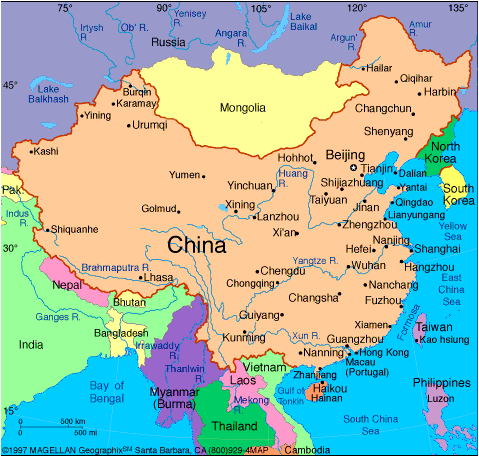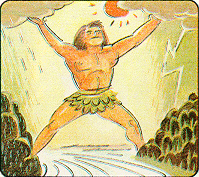

The study of the heavens was one of the central features of the Chinese civilization and
the resulting calendar was a sacred document, sponsored and promulgated by the reigning
monarch. For more than two millennia, a Bureau of Astronomy made astronomical
observations, calculated astronomical events such as eclipses, prepared astrological
predictions, and maintained the calendar. After all, a successful calendar not only
served practical needs, but also confirmed the consonance between Heaven and the
imperial court.
Analysis of oldest surviving astronomical records inscribed on oracle bones reveals a
sophisticated Chinese lunisolar calendar, with intercalation of lunar months.
Various intercalation schemes were developed for the early calendars, including the
nineteen-year and 76-year lunar phase cycles that came to be known in the West as
the Metonic cycle and Callipic cycle. From the earliest records, the beginning of
the year occurred at a New Moon near the winter solstice. The choice of month for
beginning the civil year varied with time and place, however. In the late second
century B.C.E., a calendar reform established the practice, which continues today,
of requiring the winter solstice to occur in month 11. This reform also introduced
the intercalation system in which dates of New Moons are compared with the 24 solar
terms. However, calculations were based on the mean motions resulting from the cyclic
relationships. Inequalities in the Moon's motions were incorporated as early as the
seventh century C.E., but the Sun's mean longitude was used for calculating the
solar terms until 1644.
Observing total solar eclipses was, for example, a major element of forecasting the
future health and successes of the Emperor, and astrologers were left with the
onerous task of trying to anticipate when these events might occur. Failure to get
the prediction right, in at least one recorded case in 2300 B.C. resulted in the
beheading of two astrologers.
 Chinese civilization, as described in mythology, begins with Pangu, the creator of the
universe, and a succession of legendary sage-emperors and culture heroes
who taught the ancient Chinese to communicate and to find sustenance, clothing, and
shelter. The first prehistoric dynasty is said to be Xia, from about the twenty-first
to the sixteenth century B.C. Until scientific excavations were made at early bronze-age
sites in 1928, it was difficult to separate myth from reality in regard to the Xia.
But since then, and especially in the 1960s and 1970s, archaeologists have uncovered
urban sites, bronze implements, and tombs that point to the existence of Xia civilization
in the same locations cited in ancient Chinese historical texts. At minimum, the Xia
period marked an evolutionary stage between the late neolithic cultures that followed
the settlement of nomadic tribes in the fertile valleys of the Yellow Riverand the subsequent
first Chinese urban civilization of the Shang dynasty.
Chinese civilization, as described in mythology, begins with Pangu, the creator of the
universe, and a succession of legendary sage-emperors and culture heroes
who taught the ancient Chinese to communicate and to find sustenance, clothing, and
shelter. The first prehistoric dynasty is said to be Xia, from about the twenty-first
to the sixteenth century B.C. Until scientific excavations were made at early bronze-age
sites in 1928, it was difficult to separate myth from reality in regard to the Xia.
But since then, and especially in the 1960s and 1970s, archaeologists have uncovered
urban sites, bronze implements, and tombs that point to the existence of Xia civilization
in the same locations cited in ancient Chinese historical texts. At minimum, the Xia
period marked an evolutionary stage between the late neolithic cultures that followed
the settlement of nomadic tribes in the fertile valleys of the Yellow Riverand the subsequent
first Chinese urban civilization of the Shang dynasty.
 Thousands of archaeological finds in the Huang He (Yellow River), Henan Valley --the
apparent cradle of Chinese civilization--provide evidence about the Shang dynasty,
which endured roughly from 1700 to 1027 B.C. The Shang dynasty (also called the Yin
dynasty in its later stages) is believed to have been founded by a rebel leader who
overthrew the last Xia ruler. Its civilization was based on agriculture, augmented by
hunting and animal husbandry. Two important events of the period were the development
of a writing system, as revealed in archaic Chinese inscriptions found on tortoise shells
and flat cattle bones (commonly called oracle bones or), and the use of bronze
metallurgy. A number of ceremonial bronze vessels with inscriptions date from the
Shang period; the workmanship on the bronzes attests to a high level of civilization.
Thousands of archaeological finds in the Huang He (Yellow River), Henan Valley --the
apparent cradle of Chinese civilization--provide evidence about the Shang dynasty,
which endured roughly from 1700 to 1027 B.C. The Shang dynasty (also called the Yin
dynasty in its later stages) is believed to have been founded by a rebel leader who
overthrew the last Xia ruler. Its civilization was based on agriculture, augmented by
hunting and animal husbandry. Two important events of the period were the development
of a writing system, as revealed in archaic Chinese inscriptions found on tortoise shells
and flat cattle bones (commonly called oracle bones or), and the use of bronze
metallurgy. A number of ceremonial bronze vessels with inscriptions date from the
Shang period; the workmanship on the bronzes attests to a high level of civilization.
 The beginnings of the Chinese calendar can be traced back to the 14th century B.C.E.
Legend has it that the Emperor Huangdi invented the calendar in 2637 B.C.E. The Chinese
calendar is based on exact astronomical observations of the longitude of the sun and the
phases of the moon indicating that the Chinese astronomers of the time were quite capable
of carrying out intricate and detailed observations and calculations.
The beginnings of the Chinese calendar can be traced back to the 14th century B.C.E.
Legend has it that the Emperor Huangdi invented the calendar in 2637 B.C.E. The Chinese
calendar is based on exact astronomical observations of the longitude of the sun and the
phases of the moon indicating that the Chinese astronomers of the time were quite capable
of carrying out intricate and detailed observations and calculations.
 The Chinese astronomers were among the earliest to keep systematic record of their
observations of the heavens. Sitings and records of these sitings go back over forty centuries. The
Chinese observed sunspots, meteorites, eclipses and comets which they called "guest stars." They also
observed rare events such as the splitting of comets as the record of 896 CE from the Tang Dynasty
indicates, and meteorite showers. The earliest account of the latter exists in The Chronicles of Zuo Ming
regarding such a shower in 687 BCE.
The Chinese astronomers were among the earliest to keep systematic record of their
observations of the heavens. Sitings and records of these sitings go back over forty centuries. The
Chinese observed sunspots, meteorites, eclipses and comets which they called "guest stars." They also
observed rare events such as the splitting of comets as the record of 896 CE from the Tang Dynasty
indicates, and meteorite showers. The earliest account of the latter exists in The Chronicles of Zuo Ming
regarding such a shower in 687 BCE.
"Here lie the bodies of Ho and Hi, Whose fate, though sad, is risible; Being slain because
they could not spy Th' eclipse which was invisible." - Author unknown
(Refers to the Chinese eclipse of 2136 B.C. or 2159 B.C.)
Because the pattern of total solar eclipses is erratic
in any specific geographic location, many astrologers no doubt lost their heads. By
about 20 B.C., surviving documents show that Chinese astrologers understood what
caused eclipses, and by 8 B.C. some predictions of total solar eclipse were made
using the 135-month recurrence period. By A.D. 206 Chinese astrologers could
predict solar eclipses by analyzing the Moon's motion.
 They were also one of the earliest people to make star maps:Shi Shen, an astronomer, catalgied
an eight-volume series of his observations of the heavens in the 4th century BCE. The earliest known
western star maps were made by the Greek astronomer Hiparchus in 2 BCE.
They were also one of the earliest people to make star maps:Shi Shen, an astronomer, catalgied
an eight-volume series of his observations of the heavens in the 4th century BCE. The earliest known
western star maps were made by the Greek astronomer Hiparchus in 2 BCE.
 In addition to their observations and records of the heavens, the Chinese also developed highly
sophisticated navigational systems based on the stars. Chinese sailors in the third century BCE were
already able tofind their bearings using the Great Dipper and the North Pole. In conjunction with their
observations of the heavens the Chinese also built planetariums, and various instruments including
armillaries for measuring the celestial coordinates. Scientists reading the records estimate that the
Chinese were probably using an armillary to map the heavens by the 4th century BCE.
In addition to their observations and records of the heavens, the Chinese also developed highly
sophisticated navigational systems based on the stars. Chinese sailors in the third century BCE were
already able tofind their bearings using the Great Dipper and the North Pole. In conjunction with their
observations of the heavens the Chinese also built planetariums, and various instruments including
armillaries for measuring the celestial coordinates. Scientists reading the records estimate that the
Chinese were probably using an armillary to map the heavens by the 4th century BCE.
In Chinese history, the study of astronomy was inseparable from mathematics. From the earliest times, the Chinese, according to Joseph Needham, were far in advance of of contemporary civilizations such as those of Egypt, Babylon, Greece and Rome. There is evidence for instance, that the Chinese had mastered the decimal system since the dawn of history. The earliest treatise on mathematics, Zhoubi suanjing was proably written during the Zhou Dynasty between 1030-1022 BCE. During the Han Dynasty (221BCE-220CE) several mathematical treatises were compiled by distinguished mathemeticians such as Liu Hui whose Haidao suanjing (The Sea and Island Mathematical Manual) appeared sometime around 220CE.
 The dual studies in astronomy and mathematics would result in the some of the most remarkable
inventions including the astronomical clock by the astronomer Su Song over nine hundred years ago. In
the second century CE the famous astronomer Shang Heng devised a mobile water-driven globe which
revolved in correspondence with the movements of the heavenly bodies.
The dual studies in astronomy and mathematics would result in the some of the most remarkable
inventions including the astronomical clock by the astronomer Su Song over nine hundred years ago. In
the second century CE the famous astronomer Shang Heng devised a mobile water-driven globe which
revolved in correspondence with the movements of the heavenly bodies.

|

|